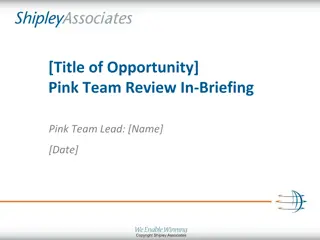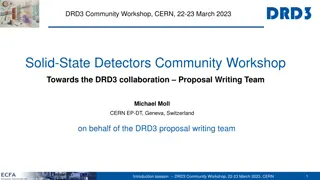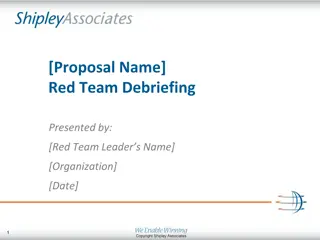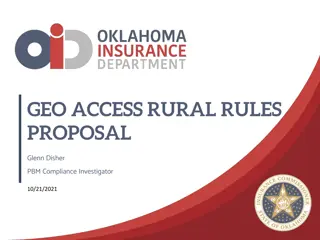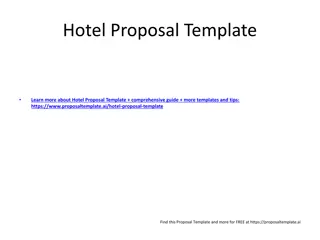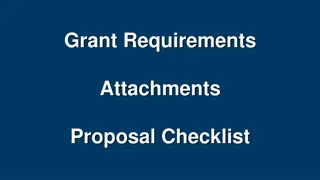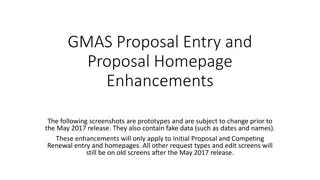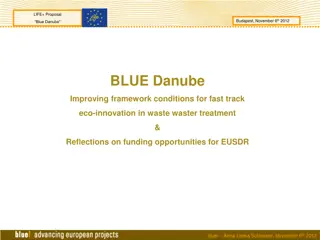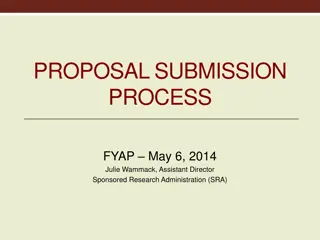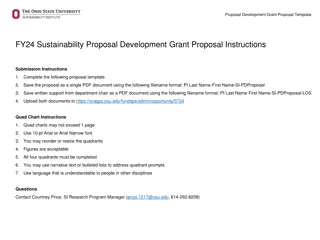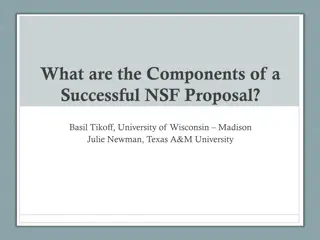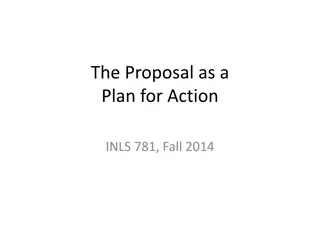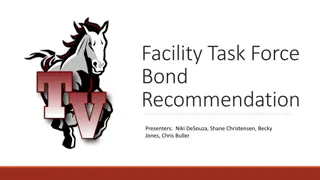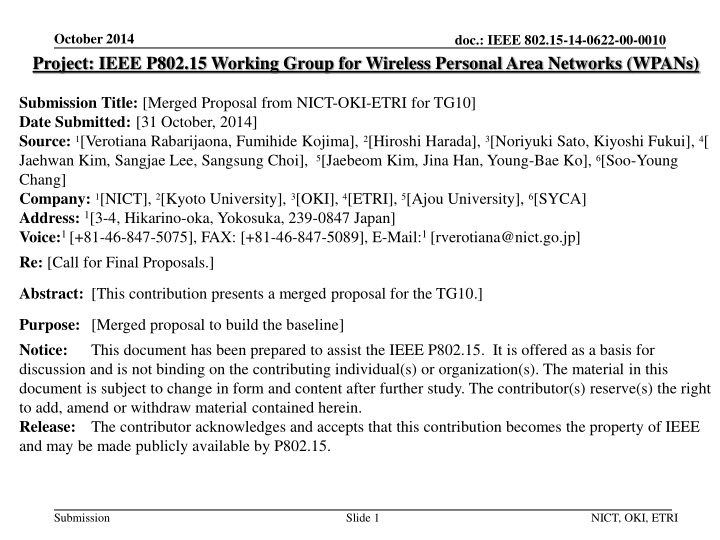
IEEE P802.15 Working Group Merged Proposal for TG10 Wireless Networks
"Explore the merged proposal from NICT, OKI, and ETRI for TG10 within the IEEE P802.15 Working Group, aiming to establish a baseline for building advanced wireless personal area networks. The proposal includes functionalities such as mesh topology discovery, routing, security, low-power operation, and more to enhance network performance and reliability."
Download Presentation

Please find below an Image/Link to download the presentation.
The content on the website is provided AS IS for your information and personal use only. It may not be sold, licensed, or shared on other websites without obtaining consent from the author. If you encounter any issues during the download, it is possible that the publisher has removed the file from their server.
You are allowed to download the files provided on this website for personal or commercial use, subject to the condition that they are used lawfully. All files are the property of their respective owners.
The content on the website is provided AS IS for your information and personal use only. It may not be sold, licensed, or shared on other websites without obtaining consent from the author.
E N D
Presentation Transcript
October 2014 Project: IEEE P802.15 Working Group for Wireless Personal Area Networks (WPANs) doc.: IEEE 802.15-14-0622-00-0010 Submission Title: [Merged Proposal from NICT-OKI-ETRI for TG10] Date Submitted: [31 October, 2014] Source:1[Verotiana Rabarijaona, Fumihide Kojima], 2[Hiroshi Harada], 3[Noriyuki Sato, Kiyoshi Fukui], 4[ Jaehwan Kim, Sangjae Lee, Sangsung Choi], 5[Jaebeom Kim, Jina Han, Young-Bae Ko], 6[Soo-Young Chang] Company:1[NICT], 2[Kyoto University], 3[OKI], 4[ETRI], 5[Ajou University], 6[SYCA] Address:1[3-4, Hikarino-oka, Yokosuka, 239-0847 Japan] Voice:1 [+81-46-847-5075], FAX: [+81-46-847-5089], E-Mail:1 [rverotiana@nict.go.jp] Re: [Call for Final Proposals.] Abstract: [This contribution presents a merged proposal for the TG10.] Purpose: [Merged proposal to build the baseline] Notice: This document has been prepared to assist the IEEE P802.15. It is offered as a basis for discussion and is not binding on the contributing individual(s) or organization(s). The material in this document is subject to change in form and content after further study. The contributor(s) reserve(s) the right to add, amend or withdraw material contained herein. Release: The contributor acknowledges and accepts that this contribution becomes the property of IEEE and may be made publicly available by P802.15. Submission Slide 1 NICT, OKI, ETRI
October 2014 doc.: IEEE 802.15-14-0622-00-0010 TG10 Merger of the proposals from NICT, OKI and ETRI (Hybrid L2R) Submission Slide 2 NICT, OKI, ETRI
October 2014 doc.: IEEE 802.15-14-0622-00-0010 List of Functionalities to merge 1. Mesh topology discovery Mesh Routing Route discovery 2. Extensible mesh routing architecture (metric alternative, selection, notification, new metrics) Routing metrics Multiple entry and exit points 3. Unicast a. Hop-by-hop retry 4. Broadcast 5. Low power operation 6. Mesh Security 7. Discovery and association 8. Changes to the MAC 9. Multicast routing a. Hop-by-hop retry Submission Slide 3 NICT, OKI, ETRI
October 2014 doc.: IEEE 802.15-14-0622-00-0010 1. Mesh topology discovery, mesh routing, route discovery - proposal The HMT construction IE and the IEs for the HELLO, PANN/PANN-RP should be merged as needed 15.4 already avails several options where the IEs can be used. The resulting IE may be included in a EB or a MP frame. EBs can be periodic or aperiodic They can have different periods depending on the IE they contain, or the IEs can be included in the same beacon. EBs with different IEs have been used in many subsequent amendments after 4e EBs can contain payload and header IEs Storing and non-storing mode should be supported Non-storing mode requires less memory but may require a lot of energy to transmit large frames due to the intermediate hops in source routing Storing mode requires memory but allows low overhead frames The size of the memory of a device is up to the implementer but all options should be covered There should be a PIB set depending on the storing mode. In storing mode, a device shall be able to store at least one parent. The final size of the neighbor table is up to the vendor. Submission Slide 4 NICT, OKI, ETRI
October 2014 doc.: IEEE 802.15-14-0622-00-0010 1. Mesh topology discovery, mesh routing, route discovery - proposal Reactive or proactive Energy constraints require proactive routing. Flooding for route establishment uses a lot of energy. The delay in route establishment is also considerable in beacon enabled PANs Reactive may be used for small networks or networks without energy constraints. Reactive protocols may also be used in networks without memory constraints so that the routes can be stored to minimize the flooding for route discovery. P2P routing Packet forwarded up until the first common ancestor then down to the destination: the routes can be very long in a large network Transversal reactive routes: may offer shorter routes but generates a lot of overhead. Necessary IEs for P2P reactive route discovery (such as PREQ- PREQ-RP) are defined. Most of the use cases require communication to and from a gateway. P2P reactive route discovery will be optional for use cases that may require P2P communication Slide 5 Submission NICT, OKI, ETRI
October 2014 doc.: IEEE 802.15-14-0622-00-0010 1. Mesh topology discovery, mesh routing, route discovery downward routing Destination announcement IE, RREC and PANN-RP fulfill the same role. PANN-RP adds the TMTCP-aware functionality. The three IEs are merged as proposed later in this presentation in the Route Announcement IE Submission Slide 6 NICT, OKI, ETRI
October 2014 doc.: IEEE 802.15-14-0622-00-0010 L2R IE format Bit: 0-10 11-14 15 Octets: 0.. 2047 Length Group ID Type = 1 Content Octet: Variable Variable Nested IE Nested IE - The use of nested IEs provides flexibility to add all the necessary functionalities - The L2R header may not be necessary as all the fields are already present in the MHR or other nested IEs Submission Slide 7 NICT, OKI, ETRI
October 2014 doc.: IEEE 802.15-14-0622-00-0010 Topology Construction IE Bits: 0-7 8- 14 15 Octets: 1/2 Octets : 0/1 1 0/2/8 0/1 1 1 0/9 Variable Variable Length Sub -ID Type = 0 Descriptor Entity ID b0: Tree Root address mode b1-7: reserved Tree Root address Depth Sequence number Construction IE interval MCO fields Path quality metric 1 Path quality metric N Bit:0 Bit: 1 2 3 4 5 6 7 8-10 Descriptors present High Reliability Data Aggregation Multi-channel Operation (MCO) Brother routing DS route required Reactive P2P discovery Storing mode Number of metrics 11 12-13 14 15 Address modes present Security modes Multicast subscription in RA Reserved Octet: 0/8 0/1 Associated PAN coord (if MCO) Allocated channel number (if MCO) Bits: 0-2 3-5 7 8-11 12-15 Octet: 0/Variable 0/Variable Path quality metric ID Priority Reserved Length of the Value (octets) Length of the Threshold (octet) Threshold Value Submission Slide 8 NICT, OKI, ETRI
October 2014 doc.: IEEE 802.15-14-0622-00-0010 Topology Construction IE description 1 All the fields after the Type are not present if the IE is in request frame (EBR). In this case, the IE is used to discover existing L2R network If a device belongs to different routing trees, it includes the corresponding number of Topology Construction IE in the EB Descriptor: indicates the functionalities available in a L2R routing instance. If the first bit is set to 0, the rest of the descriptor field is ignored, and the descriptor size is 1 octet. High reliability: if set to 1, the AR field in the MHR must be set to 1 and all the packets must be acknowledged. If set to 0, acknowledgment is optional. Data aggregation: if set to 1, data aggregation is allowed in the L2R network, otherwise, data aggregation is prohibited. If data aggregation is allowed in a L2R network, the buffering time is indicated in the PIB Multi-channel operation: indicates if multiple channels and multiple PANs are used in the L2R network. Brother routing: if set to 1, routing through a brother is allowed in the network. This implies that the network can use a loop avoidance mechanism. DS route required: if set to 1, all the devices are required to send a Route Annoucement IE to build downstream routes Submission Slide 9 NICT, OKI, ETRI
October 2014 doc.: IEEE 802.15-14-0622-00-0010 Topology Construction IE description 2 Descriptor (cont d): Reactive P2P discovery: if set to 1, reactive P2P discovery is allowed Storing mode: if set to 1, the network is in storing mode. If set to 0, the network is on non- storing mode and source routing must be used Number of metrics: indicates the number of link quality metrics at the end of the nested IE Address modes present: indicates if the address mode fields of the addresses in the IE are present. If this field is set to 0, only 16-bit addresses are used and the address mode fields are not present. Security mode: 00: none : TBD Multicast subscription in RA: if set to 1, Route Announcement (RA) may contain Multicast subscription field and multicast routing is accordingly used. If set to 0, multicast packets are flooded and filtered by the upper layer Entity ID: identifies an entity (ex: data collection entity, control and monitoring entity ) reachable through the L2R network. An entity may be reachable through several tree roots (gateway) and a tree root may be connected to several entities. Tree root address mode: present only if the Address modes present flag is set to 1 Submission Slide 10 NICT, OKI, ETRI
October 2014 doc.: IEEE 802.15-14-0622-00-0010 Topology Construction IE description 3 Tree root address: address of the root of the tree offering routing towards an entity available. Depth: Distance in hops of the transmitting device to the root of the tree, establishing parent-child and brotherhood relationship between the devices. A node that has lost all paths to the root sends a TC IE with a depth of 0xffff. Sequence number: Set by the root of the tree and propagated. Used to know the latest tree information. Several consecutive TC IE with the same SN indicates that there might be a path breakage upstream of the device transmitting the TC IE or that the tree root is not available anymore Construction IE interval: interval in (unit TBD) between each Topology construction IE. Multi-Channel Operation fields (TMCTP): present only if MCO is enabled in the descriptor Associated PAN coordinator: address of the PAN coordinator to which the transmitting device is associated. Present only if the MCO is enabled. Allocated channel number: indicates the channel on which the transmitting device is operating. Present only if MCO is enabled In multi-channel operation such as in TMCTP mode , a PAN coordinator uses two channels as Parent- Own PAN channels. The PAN channel number is inserted to the Allocated channel number field to find an available channel when the PAN channel is broken. This statement is unclear. Submission Slide 11 NICT, OKI, ETRI
October 2014 doc.: IEEE 802.15-14-0622-00-0010 Topology Construction IE description 4 Path quality metric: Describes the metric in use in the L2R network. This field also is used to inform the network of any update/change in the metrics in use. Several metrics may be used in one L2R network. This field is set by the root of the tree, and are copied and retransmitted by the other devices Link quality metric ID: identifies the metric in use in the network. The metrics used in the proposals can be assigned IDs as default metrics (hop count, SINR, Inactive Overhead Aware Link Metric). Remaining IDs may be used by the implementers Priority: indicates the priority of the current metric over other metrics that may be present Length of Value: in octets Length of Threshold: in octets. If Brother routing is set to 0, this field shall be set to 0 Value: value of the metric of the transmitting device, only present if it needs to be shared with neighbors. Threshold: present only if brother routing is set to 1. Indicates the threshold of the metric that a link with a parent must satisfy. If the threshold is not satisfied the better of the best parent and best brother is selected as a next hop Submission Slide 12 NICT, OKI, ETRI
October 2014 doc.: IEEE 802.15-14-0622-00-0010 Neighbor Link Metric IE Bits: 0 1-7 Bits: 0-7 8-14 15 Octets: Variable Variable Length Sub-ID Type= 0 Address mode present Num. of neighbors Neighbor metric container 1 Neighbor metric container N This IE should be long. A short IE can only contain the information for up to 15 neighbors considering 1 metric and 16-bit addresses. Bits: 0-3 4-5 6-7 Octets: 2/8 Variable Variable Num. of metrics Addr. mode Reserved Neighbor address Link metric 1 Link metric M Bits: 0-3 4-7 Octets: Variable Length Link quality metric ID Value Submission Slide 13 NICT, OKI, ETRI
October 2014 doc.: IEEE 802.15-14-0622-00-0010 Neighbor Link Metric IE description 1 This IE is used to inform the link metrics to the neighbor nodes, which metrics is measured in the issuer node and is related to the each neighbor. The IE is sent by broadcast on one hop. Ex. Incoming link cost Address modes present: indicates if the address mode fields of the addresses in the IE are present. If this field is set to 0, only 16-bit addresses are used and the address mode fields are not present. Number of neighbors: A number of neighbors to which the issuer node sends metric. Neighbor metric container field: contains metrics which are measured in the issuer node. Each container can carry one or more metrics. Number of metrics:indicates the number of link metrics which the neighbor metric container has. Address mode:Address mode of neighbor address Neighbor address: Neighbor s address Submission Slide 14 NICT, OKI, ETRI
October 2014 doc.: IEEE 802.15-14-0622-00-0010 Neighbor Link Metric IE description 2 Link metric field: describes the metric in use in the L2R network. This field also is used to inform the network of any update/change in the metrics in use. Several metrics may be used in one L2R network. Which fields are used is decided by the root of the tree, and they are propagated to the other devices Length: represents the length of this field. Link quality metric ID: identifies the metric. The metrics used in the proposals can be assigned IDs as default metrics (hop count, SINR, Inactive Overhead Aware Link Metric). Remaining IDs may be used by the implementers Value: value of the link metric between the transmitting device and the neighbor Submission Slide 15 NICT, OKI, ETRI
October 2014 doc.: IEEE 802.15-14-0622-00-0010 Route Announcement IE Bits: 0- 10 11-14 15 1 Octets: 0/1 0/1 0/2/8 0/9 Octets: 0/1 1 0 - Variable Length Sub- ID Type = 1 Descriptor Entity ID b0: Tree root address mode b1-7: reserved Tree Root address Multi-channel operation fields Multicast subscription Number of intermediate addresses Intermediate addresses list Bit Flag 0 Inter-PAN Communication Bits: 0-5 6-7 Octets: 0/2 0/2 1 Multicast subscription 2 Address modes present Number M of multicast group2 Reserved Multicast address 1 Multicast address M 3-7 Reserved Octets: 0/8 0/1 Octets: 0/1 0/2/8 0/1 0/2/8 Associated PAN coordinator extended address Allocated channel number b0: Intermediate hop address mode 1 b1-7: reserved Intermediate hop address 1 b0: Intermediate hop address mode N b1-7: reserved Intermediate hop address N Submission Slide 16 NICT, OKI, ETRI
October 2014 doc.: IEEE 802.15-14-0622-00-0010 Route Announcement IE description 1 Used to build downstream routes and/or to announce a subscription to a multicast group. In the latter case, the multicast addresses announced are treated as unicast addresses for routing Descriptor: bitmap informing of information present in the IE Inter-PAN communication: indicates if the routing tree spans several PANs the MCO fields are required Multicast subscription flag:indicated the presence or absence of the multicast subscription field. Address modes present: indicates the presence of the address modes in the IE. If set to 0, only short addresses are used Entity ID: identifies an entity (ex: data collection entity, control and monitoring entity ) reachable through the L2R network. Tree root address mode: present only if the Address modes present flag is set to 1 Tree root address: address of the root of the tree offering routing towards an entity available. Submission Slide 17 NICT, OKI, ETRI
October 2014 doc.: IEEE 802.15-14-0622-00-0010 Route Announcement IE description 2 Multi-channel operation fields: fields regarding the MCO. These fields are present only if the bit for Inter-PAN communication in the Device Status is set to 1 Associated PAN coordinator extended address: address of the PAN coordinator which the transmitting device is associated to. Allocated channel number: indicates the channel on which the transmitting device is operating. Multicast subscription: Number of multicast group: number of multicast groups to which the source of the destination announcement IE belongs. Multicast address: address of the multicast group to which the source of the destination announcement IE belongs. L2R will have a block of 2 byte addresses reserved for multicast groups (ex: 0xff00 ~ 0xfffd). Subscription and mapping to the multicast groups are up to the implementer and out of the scope of L2R. NICT suggest only using short addresses for multicast routing Submission Slide 18 NICT, OKI, ETRI
October 2014 doc.: IEEE 802.15-14-0622-00-0010 Route Announcement IE description 3 Number of intermediate addresses: Number of addresses in the intermediate address list. Intermediate addresses list: list of addresses between the source of the downstream route announcement and the root of the tree. Each intermediate hop device appends it own address before forwarding the IE. This list is present only if the network is in non-storing mode. If the address mode is not present short addresses are used. What is the need for the next hop to the root node (ETRI)? Submission Slide 19 NICT, OKI, ETRI
October 2014 doc.: IEEE 802.15-14-0622-00-0010 Short Route Announcement IE We propose to use a short version of the Route announcement for very small scale PANs such as a HAN. - As the route announcement, it is used by a device to make itself know unto the tree root. - It is also used by a device to inform a neighbor of a destination that may be reached through it. Bits: 0-7 8-14 15 16-20 21-23 Octets: 0/2/8 1 0 - Variable Length Sub-ID Type = 0 Reserved Priority Route Destination Address Number of intermediate addresses Intermediate addresses list Priority: set by the transmitter of the SRA IE to allow a device to select a route to the advertised destination in case it has received more than one SRA IE. The priority depends on the type of device (ex: Sleeping, non-sleeping, ) and is TBD Route Destination Address: address of the final destination device of the route announcement provided. Number of intermediate addresses: Number of addresses in the intermediate address list. Intermediate address list: list of addresses between the source of the downstream route announcement and the root of the tree. Each intermediate hop device appends it own address before forwarding the IE. Submission Slide 20 NICT, OKI, ETRI
October 2014 doc.: IEEE 802.15-14-0622-00-0010 Reactive P2P IE (PREQ) Destination address is inserted to MAC header Which destination is referred to here? There is already a destination address field in the IE below (ETRI) Bits: 0-7 8-14 15 1 Octets: 2/8 2/8 1 1 4 0/1 Allocated channel number Length Sub-ID Type = 0 Destination address Source Address HOP Count sequence number Descriptor TTL Bit: 0 1 2 3-7 Inter-PAN Comm. Request Direct Response Multi-channel operation (TMCTP) Reserved Note: - Link quality metrics are not needed here. They are already advertised during the L2R mesh discovery with the Topology construction IE. - Data aggregation is not needed here. It is already indicated during the L2R mesh discovery with the Topology construction IE Submission Slide 21 NICT, OKI, ETRI
October 2014 doc.: IEEE 802.15-14-0622-00-0010 Reactive P2P IE Description (1) Destination address :indicate the destination address that the source node want to find. Extended addressing must be used if Inter-PAN communication is enabled Source address :indicate the source address of the Reactive P2P discovery message. Extended addressing must be used if Inter-PAN communication is enabled Descriptor Inter-PAN communication: if set to 1, the device allows the inter PAN communication that is utilized to find path to alternative gateway. Is it not used to inform that the routing may be done across different PANs? An alternative gateway may be found in the same PAN. Direct response: if set to 1, any intermediate device that has destination route information directly respond (Reactive P2P-RP) to the originator node. Multi-channel operation: indicates if multiple channels and multiple PANs are used in the L2R network (TMCTP operation). How is this different from the Inter-PAN communication field? Inter-PAN implies that there are several PANs and therefore several channels as well. The two fields should be merged into one as in the Reactive P2P-RP Submission Slide 22 NICT, OKI, ETRI
October 2014 doc.: IEEE 802.15-14-0622-00-0010 Reactive P2P IE Description (2) Allocated channel number: present only if Inter-PAN communication is enabled. Indicates the channel that is the Parent or Assigned channel of the each device (source, forwarder) which is not currently operating. Unclear. Is this field updated at each hop? HOP Count:the number of hops from the source node TTL:Maximum number of flooding hops. What if the TTL is reached but no response is received? Sequence number:indicates the sequence number of reactive P2P message that is utilized to avoid loop. Submission Slide 23 NICT, OKI, ETRI
October 2014 doc.: IEEE 802.15-14-0622-00-0010 Reactive P2P-RP IE (PREQ-RP) Bits: 0-7 8-14 15 1 Octets: 2/8 2/8 0/1 Length Sub-ID Type = 0 Device Status Source address Destination address Allocated Channel number Bit: 0 1-7 Inter PAN Communication Reserved Note: - Data aggregation is not needed here. It is already indicated during the L2R mesh discovery with the Topology construction IE - Gateway enabled is not necessary. The address of the device providing the gateway is already advertised during the L2R mesh discovery through the Topology construction IE. Any device whose address does not match a tree root address is not a gateway. Submission Slide 24 NICT, OKI, ETRI
October 2014 doc.: IEEE 802.15-14-0622-00-0010 Reactive P2P-RP IE Description (1) Device status Inter-PAN communication: if set to 1, the routing is be done across several PANs Destination address :indicate the destination address that the source node want to find. Extended addressing must be used if Inter-PAN communication is enabled Source address :indicate the source address of the Reactive P2P discovery message. Extended addressing must be used if Inter-PAN communication is enabled Allocated channel number: present only if Inter-PAN communication is enabled Submission Slide 25 NICT, OKI, ETRI
October 2014 doc.: IEEE 802.15-14-0622-00-0010 L2R Routing IE The L2R Routing IE is added to a data frame to enable its routing. A device looks at the destination address therein and finds the appropriate next hop based on its neighbor/routing table when source routing is not used Bits: 0-10 11-14 15 Octets:1 0/1 0/1 2/8 Octets: 0/Variable 1 Length Sub-ID Type = 1 Descriptor Entity ID Bit 0: Tree root address mode Bits 1-7: reserved Tree Root address Addressing fields (original source and final destination) L2R sequence number 1 1 0/1 0 - Variable TTL Number of retry Number of intermediate addresses Intermediate addresses list Bits: 0 1 2 3 4 5 6 7 Data aggregation Source routing Inter-PAN communication L2R Retransmission Low delay Guaranteed transmission Address modes present Reserved Submission Slide 26 NICT, OKI, ETRI
October 2014 doc.: IEEE 802.15-14-0622-00-0010 L2R Routing IE - The next hop address is present in the MAC header and does not need to be repeated here - The link metric is not needed during routing. It is advertised during the mesh discovery with the Topology construction IE - What is the need for including Next hop channel ? The allocated channel is already recorded during the mesh discovery and route discovery process (Topology construction IE, DS RA IE, Reactive P2P/-RP) What is the need for the hop count field? - If these fields are only needed for the routing table/neighbor table, they do not need to be included in the IE What is the need for the Route expiration time field? - What is the need for Uplink direction/ Downlink direction? - Submission Slide 27 NICT, OKI, ETRI
October 2014 doc.: IEEE 802.15-14-0622-00-0010 L2R Routing IE description 1 Descriptor Data aggregation: indicates if the current packet can be aggregated. Source routing: if set to 1, an intermediate address list is present. Inter-PAN communication: if set to 1, the routing is be done across several PANs L2R retransmission: indicates if retransmission through an alternative neighbor is allowed for the current packet Low delay: if set to 1, the current packet shall be placed at the head of the queue for immediate forwarding. If there is already one or more packets requiring low delay in the queue, the packet is placed before the first packet that does not require low delay. Guaranteed transmission: If set to 0 and if the queue is full, the current packet may be discarded. If set to 1, the current packet must be buffered in the queue. It shall replace the first packet that does not require guaranteed transmission in the queue. Address modes present: indicates the presence of the address modes in the IE. If set to 0, only short addresses are used Submission Slide 28 NICT, OKI, ETRI
October 2014 doc.: IEEE 802.15-14-0622-00-0010 L2R Routing IE description 2 Entity ID: : identifies an entity (ex: data collection entity, control and monitoring entity ) reachable through the L2R network. Tree root address mode: present only if the Address modes present flag is set to 1 Tree root address: address of the root of the tree offering routing towards an entity available. Addressing fields: PAN ID the original source and final destination: present only if inter-PAN communication is enabled Address modes of the original source and final destination addresses: present only if the Address modes present flag is set to 1 Address of the original source and the final destination. L2R sequence number: sequence number of the data frame being routed TTL: Time to live to avoid infinite loop Number of retry: track the number of times a packet has been retransmitted. Submission Slide 29 NICT, OKI, ETRI
October 2014 doc.: IEEE 802.15-14-0622-00-0010 L2R Routing IE description 3 Number of intermediate addresses: present only if source routing is set to 1. Indicates the number of intermediate addresses between the source and the final destination. The number is decreased by 1 at each hop. Intermediate address list: present only if source routing in the Topology construction IE is set to 1. Each intermediate hop removes its address before forwarding the packet. Each address is preceded with an Address mode field if the Address mode present flag is set to 1 Submission Slide 30 NICT, OKI, ETRI
doc.: IEEE 802.15-14-0622-00-0010 Slide 31 Routing Table from ETRI How is this Routing Table used? Is it supposed to be included in an IE or is it a way to store the routing information? Oct: 8 1 8 1 1 4 8 1 1 1 Destination Address (extended) Depth Associate d PAN ID HOP Count L2R Sequence Number Route Expiration Time NextHop Address (Extended) NextHop Channel Link Metric L2R Status Bit: 0 1 2 3 4 5 6 7 Uplink Direction Downlink Direction Inter PAN Comm. Gateway Enabled Multi- channel Multicast route Aggregation Enabled Reserved Submission
October 2014 doc.: IEEE 802.15-14-0622-00-0010 Short L2R Routing IE We propose to use a short routing IE (in order to accommodate very small scale networks such as Home Energy Management Systems (HEMS) networks with only one PAN Bits: 0-7 8-14 15 Octets: Variable 1 Octets: 0/1 0 - Variable Length Sub-ID Type = 0 Addressing fields (original source and final destination) L2R sequence number Number of intermediate addresses Intermediate addresses list Submission Slide 32 NICT, OKI, ETRI
October 2014 doc.: IEEE 802.15-14-0622-00-0010 3. Unicast - Hop-by-hop retry Unicast routing using the L2R Routing IE. Hop-by-hop retry Legacy 802.15.4 retransmission when MCO is enabled Retransmission to next best parent when possible Retransmission to best brother or next best parent, only if Brother routing in the Topology construction IE is enabled Submission Slide 33 NICT, OKI, ETRI
October 2014 doc.: IEEE 802.15-14-0622-00-0010 4. Broadcast Flooding with record of the source address and sequence number. Discarding of seen packets Use of random jitter (such as a trickle timer) Submission Slide 34 NICT, OKI, ETRI
October 2014 doc.: IEEE 802.15-14-0622-00-0010 5. Low power operation Low power operation is informed by the MAC (CSL, RIT, Beacon enabled mode ) Forwarding of packets must be synchronized with the awake time of the next hop Trickle timer may be used for frames that need flooding There seems to be an IPR statement on MPL ID from Nokia. Is it possible to use it without applying it to MPL? Submission Slide 35 NICT, OKI, ETRI
October 2014 doc.: IEEE 802.15-14-0622-00-0010 6. Mesh security 3 modes of operations pre-shared, KMP, non security The mode in use in the network should be informed by the beacon. KMP Scheme should be considered with conjunction with discovery and association procedure. The functions as follows may be required to define Detection of short address duplication Procedure of solving PAN ID confliction Etc. Submission Slide 36 NICT, OKI, ETRI
October 2014 doc.: IEEE 802.15-14-0622-00-0010 7. Discovery and association Association to the PAN with 802.15.4 MAC Association to the L2R network with EB/HELLO request/response Discovery of the L2R network with EB/HELLO request/response Submission Slide 37 NICT, OKI, ETRI
October 2014 doc.: IEEE 802.15-14-0622-00-0010 8. Changes to the MAC Topology construction IE L2R routing IE Destination announcement IE P2P reactive routing IE Other IEs Submission Slide 38 NICT, OKI, ETRI
October 2014 doc.: IEEE 802.15-14-0622-00-0010 9. Multicast routing Reserving a block of short addresses for multicast (ex: 0xFF00 ~ 0xFFFD). Mapping between the short addresses and the multicast addresses is up to the implementer. Subscription/leave is an upper layer function treated as data frames by L2. We suggest only using short addresses for multicast routing. Multicast address assignment and de-assignment is conducted through primitives from the next upper layer Two types of multicast Flooding + higher layer filter recommended for small scale networks or non energy constrained networks Going up by unicast, going doing by multicast reduced number of transmissions recommended for large scale networks and energy constrained networks, requires the multicast subscription field Submission Slide 39 NICT, OKI, ETRI


